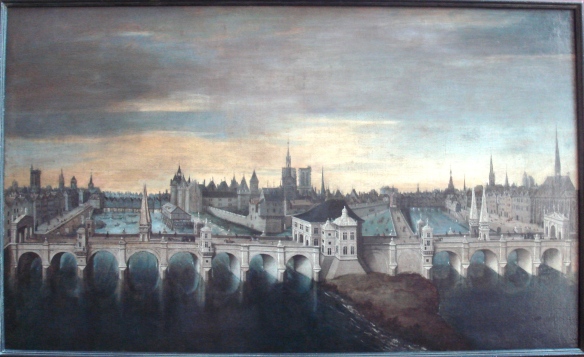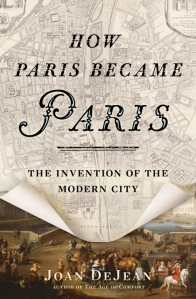Excerpt from The Invention of Paris by Joan DeJean.
“Artists quickly began to turn out images of this new kind of signature monument … Almost all of them are scenes of hustle and bustle, of hurly-burly, positively overflowing with people and activity. They portray urban life as diverse, gritty-fueled by sometimes uneasy excitement. One glance at any of them and you knew a great deal about the sort of place that Paris was becoming. “The New Bridge became the first celebrity monument in the history of the modern city because it was so strikingly different from earlier bridges. It was built not of wood, but of stone; it was fireproof and meant to endure — it is now in fact the oldest bridge in Paris. The Pont Neuf was the first bridge to cross the Seine in a single span. It was, moreover, most unusually long — 160 toises or nearly 1,000 feet — and most unusually wide — 120 toises or nearly 75 feet — far wider than any known city street.
“The Pont Neuf was the first major city bridge built without houses lining both sides. Anyone crossing it could take in the sights from the bridge, and Parisians and visitors began a love affair with the river from a viewing platform seventy-five feet wide.
“Along each side where earlier bridges had houses, the New Bridge featured instead spaces reserved for pedestrians; they were raised in order to exclude vehicles and horse traffic. We would call them ‘sidewalks’; they were something that had not been seen in the West since Roman roads and something that had never been seen in a Western city. Add to this the fact that the Pont Neuf was the first bridge whose entire surface was paved, as all the new streets of Paris soon would be, and it’s easy to see why pedestrians saw themselves for the first time as kings of the river.
“The bridge proved essential to the flow of traffic across Paris: before, just getting to the Louvre from the Left Bank had been a famously tortuous endeavor that, for all those not wealthy enough to have a boat waiting to ferry them across, required the use of two bridges and a long walk on each side. The New Bridge also played a crucial role in the process by which the Right Bank became fully part of the city: in 1600, its only major attraction was the Louvre, whereas by the end of the century, the Right Bank showcased important residential architecture and urban works, from the place Royale to the Champs-Élysées. In addition, whenever a major event transpired in seventeenth-century Paris, it either took place on the Pont Neuf or was first talked about on the Pont Neuf. Nearly two centuries after its completion, author Louis Sébastien Mercier still considered the New Bridge ‘the heart of the city.’
“The Pont Neuf set higher standards for European bridges. The city’s first pathbreaking public work also had a direct and profound impact on the daily life of Parisians. It introduced them to a new kind of street life, and it transformed their relation to the Seine. The Pont Neuf was never merely a bridge: it was the place where Paris first became Paris, as well as the place where the modern city’s potential first became evident.”


